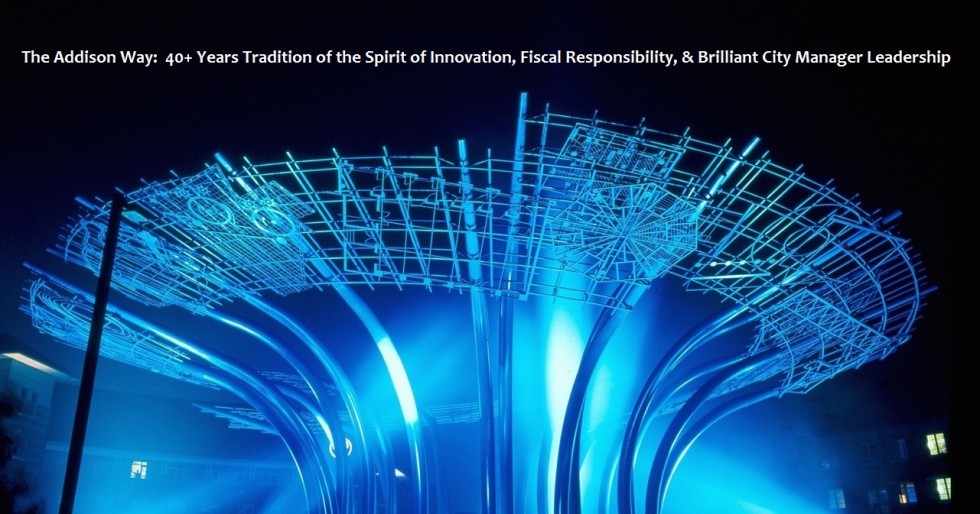Paul Walden, Addison City Council, Post (Facebook)
February 2, 2017
Rumors and misinformation are circulating regarding the proposed AMLI apartment development on Specturm Drive that will come before the Council on February 14th. In an effort to acquire accurate information, City Manager Wes Pierson responded to questions submitted by the Council.
Question 1: Articulate the reasons the site is not appropriate for Townhomes
Answer 1: Staff has not stated that the site is inappropriate for Townhomes. However, when comparing various uses it becomes a question of “highest and best use” for the property. Staff has stated that apartments are a higher and better use at this location than Townhomes. The case an apartment use at this site includes:
Apartments are typically used to buffer high-density and high-intensity commercial uses from owner-occupied housing (i.e. single-family). This shields the owner occupied units from the noise and traffic often associated with more lively commercial uses. If you refer to the layout of Addison Circle and Addison Grove, most of the Townhomes are somewhat secluded from the commercial areas and are separated by the apartments. If this site were to develop as Townhomes, there would be no such buffer.
Apartment complexes have the flexibility to move residents who may have some issue to another location on the property. If that does not work out, the renter is not tied to that property long-term the same way an owner might be.
These points may be issues for owners as the site is surrounded by tall structures (up to 16 stories) with an existing restaurant across the street (with an outdoor patio) as well as an additional site that is a logical location for another restaurant in the future. Home owners typically have a different expectation for the private enjoyment of their property than renters.
Another question to consider is the financial feasibility of Townhomes on this site. The Town has high development standards for structures, streetscapes and infrastructure. Additionally, the sewer line serving this property must be upgraded for development of any kind to occur on this site. The estimated cost to upgrade that line is around $1 million. For development to occur at this time, this cost would be the responsibility of the developer.
Townhomes would also require the addition of more public infrastructure than the apartment development. AMLI would require no new roads and would address sidewalks only around the perimeter of the site. Additionally, their utility services would tie directly into the existing systems for water, sewer and drainage with no new main lines required (note AMLI will pay for the upsizing of the existing sewer line).
Alternatively, Townhomes would necessitate additional streets and alleys, interior sidewalks plus those on the perimeter, and a significant amount of added infrastructure for new main lines for the Town’s water, sewer, and drainage systems. All of these costs raise the per unit development costs. Due to the size of parcel to be developed, Townhomes may not provide the ROI needed to attract a developer without the Town subsidizing the project (i.e. paying for public infrastructure, etc.). Staff has discussed this site with a Townhome developer and they shared that the only way that they would be interested in the site is if the Town covered all of the infrastructure costs associated with the development.
If the Town wanted to provide an incentive to encourage Townhome development, you can assume infrastructure costs of between $2-3 million. A basic ROI calculation on the Town’s investment, assuming $125,546 annual property tax revenue from Townhomes, would be between 16-24 years. This calculation does not include the maintenance costs of the new infrastructure.
Question 2: Property Tax Comparison between various uses
Answer 2: This comparison requires several assumptions. First, AMLI has represented that their development would be worth $60 million. Given recent apartment development, this seems like a reasonable assumption. Second, to make the Townhome calculation, staff is suggesting that 80 Townhomes could fit on the site with an average value of $350,000. For the office calculation, staff used the improvement and business personal property tax values for Knoll Trail Plaza (16500 Dallas Parkway) for the smaller office building and Addison Circle One (15601 Dallas Parkway) for the larger office building. A 300,000 square foot office building represents a “best case” scenario for office development, but a development similar to Knoll Trail Plaza is more likely given the site’s limitations.
To calculate the revenue, staff combined the land value of the Quorum site with the improvement and business personal property tax values for the comparison buildings.
Given these assumptions, here is an estimate of the property tax revenue the Town would receive for each development type. Please note these are very high-level calculations.
Due to size constraints the table would not fit in this space so calculations summarized below:
AMLI project would generate $336,283 in revenue
Townhomes would generate $125,546 in revenue
Office (large example) would generate $288,945 in revenue
Office (small example) would generate $119,712 in revenue
Development Size Value Taxable Value Revenue
Apartments 349 units $60,000,000 $60,000,000 $336,283
Townhomes 80 units $28,000,000 $22,400,000 $125,546
Office 120,000 sq/ft $21,359,080 $21,359,080 $119,712
Office 300,000 sq/ft $51,553,787 $51,553,787 $288,945
